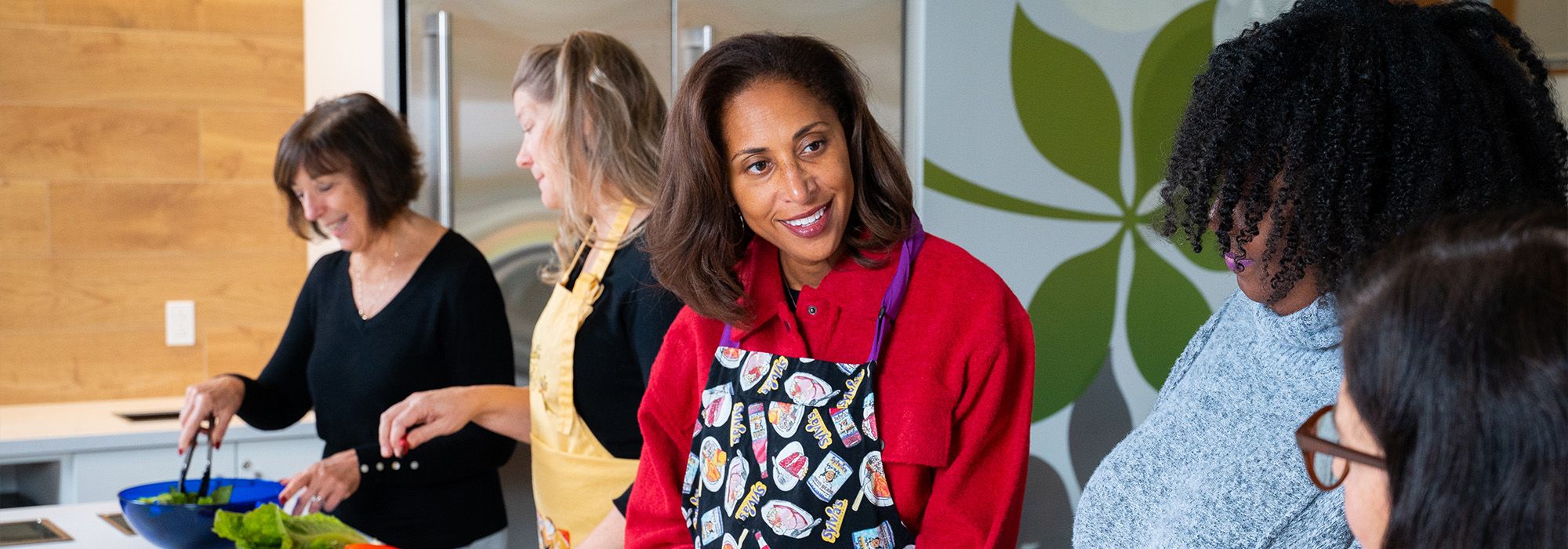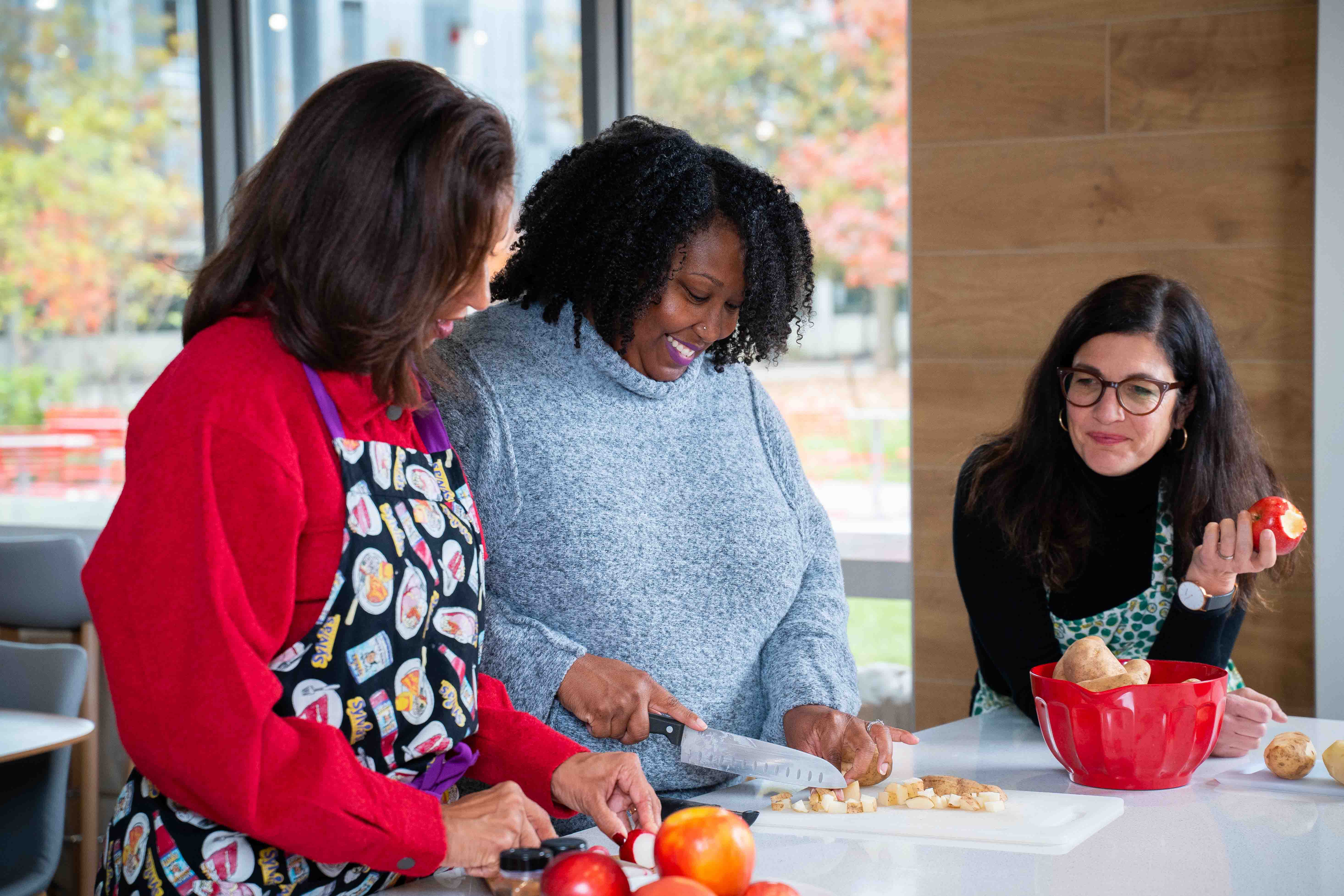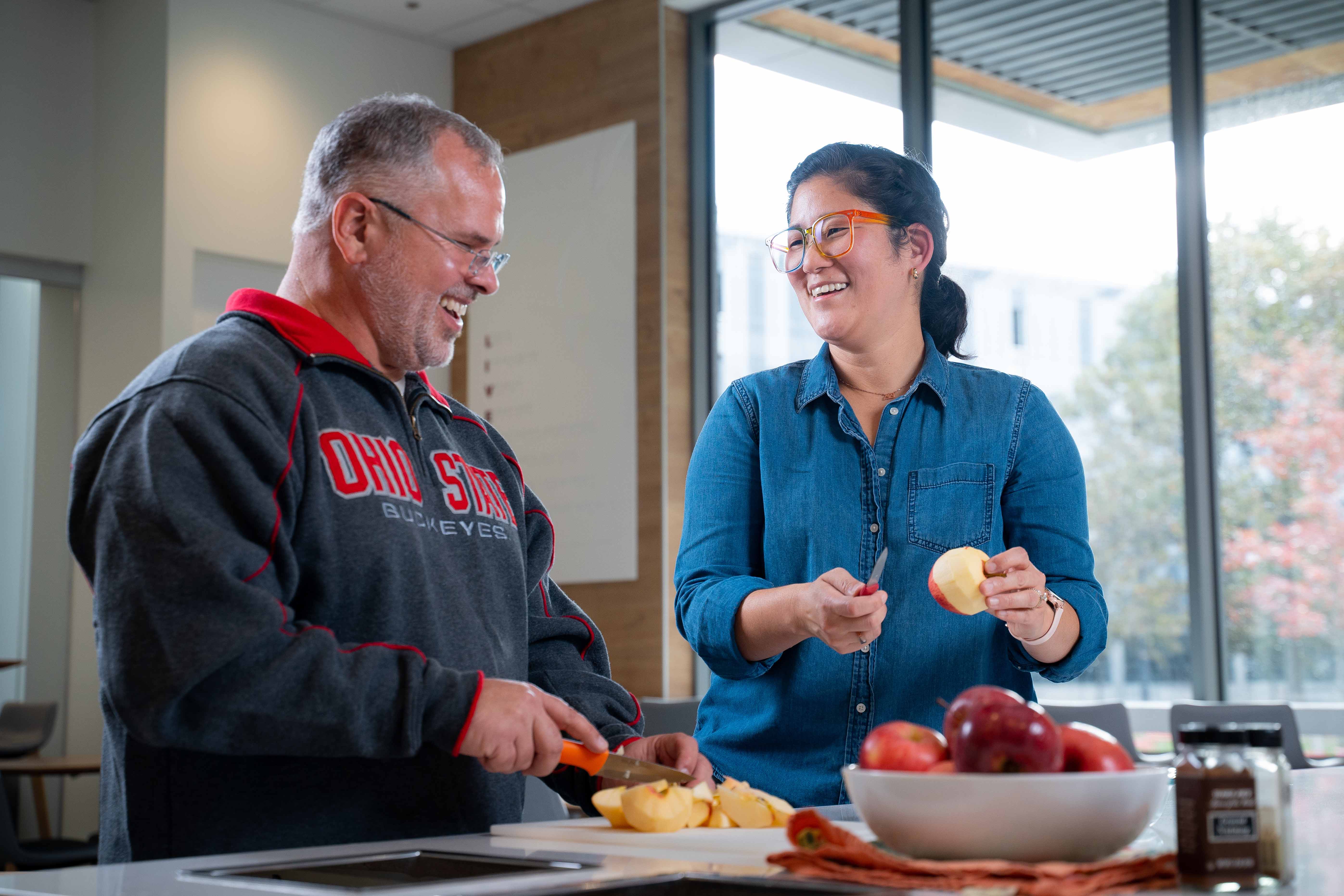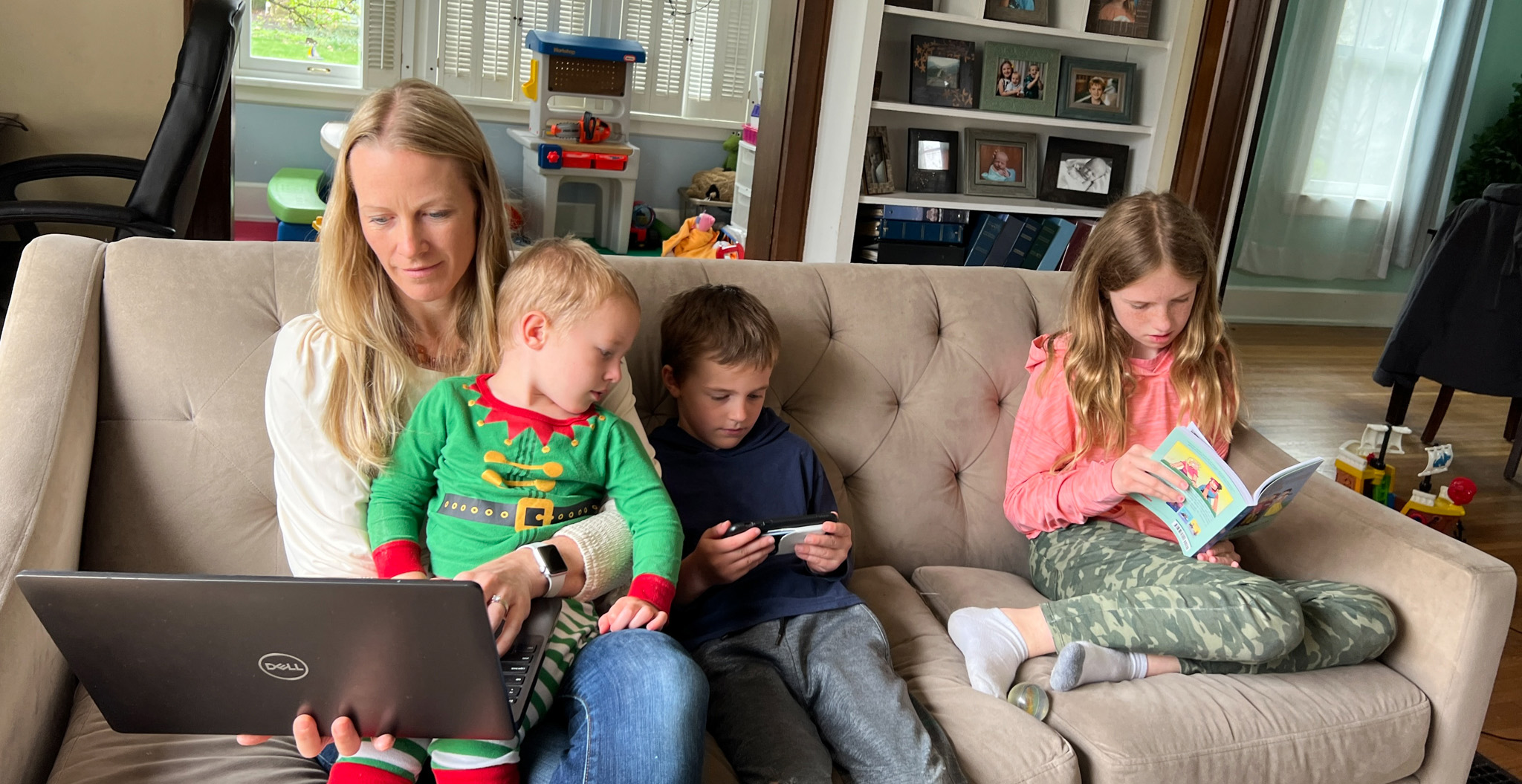
All in It for the Same Goal: PhDs and DNPs Collaborate
Faculty with DNPs and PhDs are merging their separate lanes to work together
by Victoria Ellwood
We asked faculty from this article to display their collaborative spirit in Jane E. Heminger Hall's Barbara and Lawrence Berger Demonstration Nutrition Kitchen. Photos by Andrew Weber.
Traditionally, College of Nursing faculty PhDs and DNPs have approached new endeavors and project solutions from their unique – but separate – perspectives. The PhD-prepared professionals would sharpen their research tools, generate new knowledge and analyze data, while the DNPs would take a more evidence-based practice approach to translate findings into practice.
Lately though, these doctorally prepared professionals have found that merging their diverse approaches and working together can bring more robust results and valuable outcomes.
“Both experts bring unique perspectives because of their background and training, and this definitely benefits all of our work,” says Susie Breitenstein, PhD, RN, FNAP, FAAN, assistant dean for research and innovation. “That’s why we are seeking each other out. It’s all part of what we call interdisciplinary or ‘team’ science. You have a broad team that contributes different skills and perspectives, and that brings a holistic approach to the work.”
Journal article examines DNP and PhD pathways
Randee Masciola, DNP, APRN-CNP, WHNP-BC, FAANP, director of the DNP program, and Cindy Anderson, PhD, APRN-CNP, ANEF, FAHA, FNAP, FAAN, senior associate dean, recently teamed up to publish “Professional development: the DNP and PhD as a WHNP,” an article that examines the two doctoral pathways.
“The (PhD) researchers often don’t deal directly with patients. Instead, they ask the questions, they do the research. They are nurse scientists,” Masciola explains. “The role of the DNP, as a clinical expert, is to translate existing research and implement it in a clinical setting.”
The problem, she explains, is the two groups have historically worked in separate lanes. “Researchers may come up with the questions, but if they are not associated with patient care, the projects may not be pertinent to clinicians. By the same token, the clinician doesn’t have the research background to ask the hypothetical questions and to design the research study. So it takes collaboration to have a research study that is going to be impactful on patient care.”
Masciola says the past five years have seen an increase in such collaborations in the academic community. At Ohio State, the willingness to listen to each other is definitely growing.
Gathering teams with unique skills
Breitenstein says the process of collaborating means learning to lean on each other’s skills. “I do a lot of research in pediatric primary care, so I may want a partner who has direct pediatric primary care expertise,” she says.

Recently, she and Stephanie Hosley, DNP, APRN-CNP, CNE, teamed up, along with Shaunta Stanford, EdD, APRN-CNP, ANCP-BC, CCRN, director of the Community Health Worker training program. Their aim was to embrace a project on education innovation for nurse practitioners by increasing diversity of standardized patients and improving understanding of diverse patient populations.
“Being a person of color, one of the things that stood out to me is that there were minimal models of color (in the standardized patient pool) in the pediatric program,” Hosley says. “Although people are people, sometimes our approach varies. If we are going to improve education of our students, we need to be sure as healthcare providers they will be asking the same questions across the board no matter how the person looks. They need to have the opportunity to practice, but part of the challenge was recruiting persons of color – especially with children – to participate.”
As a DNP, Hosley was ready to measure the impact of a study, but needed help getting started. Breitenstein assisted in developing the evaluation metrics and suggested looping in Stanford’s Community Health Worker students of color and their children to participate as standardized patients. With all the partners involved, the study is broadened and enriched, the CHW students log clinical experience, and their children get an introduction to a healthcare environment.
“All of our team members bring unique skills to the project. It’s really the perfect balance,” Hosley says. “The PhD perspective was to look at the questions and determine how we can measure the impact of the study. My perspective is to look at the evidence and then bring it back into the clinical setting. Together, we can use the results to improve student assessment skills, and ultimately improve patient care.”
Collaborating to address an immediate issue
Jin Jun, PhD, RN, came to Ohio State during the pandemic, bringing a keen interest in researching nurse burnout with her. “Nurse burnout and occupational stress have always been issues, but that really blew up during the COVID pandemic,” she said. “Nurses were saying they couldn’t work, they couldn’t sleep, they were stressed out and craving unhealthy, sugary foods.
“As a nurse-burnout researcher, I felt helpless because I had always looked at organizational behavior and organizational outcomes, but those changes take a long time. The nurses needed help now.
So, I had an idea to look at the mind/body connection, and how unhealthy behaviors can come out in the body as things like back pain, joint pain and insomnia. I wanted to do a study on using probiotics or some kind of noninvasive innovation to help engage nurses in healthier behavior and break the cycle.”

Jun needed a direct introduction to nurses and a clinical connection to do the study. Enter Todd Tussing, DNP, RN, CENP, NEA-BC, who coincidentally lived in the same neighborhood as Jun.
“I didn’t know any nurses, but started working with Todd because he is clinically engaged and has a lot of connections with nursing students and faculty, as well as an extensive history with Ohio State.
“I could bring the research idea, and the data collection and analytics expertise. Todd could leverage his DNP network and engage with nurses and nurse leadership for involvement in the study.” The two connected through Esther Chipps, PhD, RN, who helps bridge research studies between the medical center and the College of Nursing.
In the end, it was a natural collaboration. “I’ve been a nurse now for 17 years, a trauma nurse for over a decade,” Jun says. “Todd and I just jived well and could understand the challenges nurses face. He saw what I saw, and vice versa, even though our approaches are different. It didn’t seem like an effort to make the collaboration happen. At the end of the day, we are all in it for the same goal.”
Jun says their project, Probiotics for Occupational (PRO) Health Study is currently under IRB review; she hopes it gets underway later this fall.
Breitenstein sums it up this way: “On these types of projects, everyone works well together and respects each others’ areas of expertise. We have people who are experts in practice, experts in education, experts in research. All of those pieces help bring a really tight project together.” Jun goes even further: “For me, the DNP/PhD collaboration is as natural as the air I breathe.”
Addressing relevant issues to help society
When Kate Gawlik, DNP, and Bern Melnyk, PhD, teamed up to study working parent burnout, their report provided something people greatly needed: a name for what they were feeling, evidence to show the serious nature of this situation and potential solutions and tools, including a scale parents could access to measure their burnout and its potential impact on their families. Media attention – starting with a “TODAY” Show exclusive segment – spread across the country and around the world and reached thousands of working parents in crisis.
First-ever Working Parent Burnout Report Gains National Attention
“Pandemic parenting: Examining the epidemic of working parental burnout and strategies to help,” a report issued by The Ohio State University Office of the Chief Wellness Officer and the College of Nursing, was based on a survey to measure not only the impact of burnout on working parents, but also on their children. The survey conducted between January – April 2021 brought to light the level of burnout among working parents during the COVID-19 pandemic and the adverse consequences of that burnout for parents and their children.
“As a working parent, I feel like this pandemic has broken me,” one respondent said.

Kate Gawlik, DNP, APRN-CNP, FAANP, FNAP, co-author of the report and mother of four children ages 10 and under, could relate. “It’s just this overwhelming sense of having to be on 24/7 in so many different roles and just having to be invested in those roles so intensely.”
“We’re not going to just magically come out of the COVID-19 pandemic,” said co-author Bernadette Melnyk, PhD, APRN-CNP, FAANP, FNAP, FAAN. “We have to do so much more on the prevention side of things and not wait until parents and/or their children are in crisis.”
Working parents with children under the age of 18 living with them self-selected to participate in the survey. An alarming sixty-six percent (66%) of working parents responding met the criteria for burnout. Key findings included associations with burnout and depression, anxiety and increased alcohol consumption in working parents, as well as the likelihood for parents to be irritable, get easily angered with their children and engage in punitive parenting practices. According to parents’ self-reporting, the presence of working parent burnout has a strong association with negative behaviors in their children, too.
Within the report, Gawlik and Melnyk created a first-of-its-kind, 10-item Working Parent Burnout Scale to provide a “self-check” for parents to score themselves and determine their level of burnout. The report also provides key strategies and resources that both parents and their children can use to understand the steps they can take to prevent or improve the burnout symptoms that are adversely affecting themselves and their families.
The need for this information can be measured by how quickly and widely it spread across the nation and around the world. In the hours after NBC’s “TODAY” Show aired a special segment on the report, nearly 12,000 parents accessed the 10-question burnout scale Melnyk and Gawlik created on the show’s website. Extensive national and international media coverage followed, including two articles and an interactive quiz in The New York Times and coverage via USA Today, WebMD, CBS News Radio and podcasts from America to Australia.
In this issue
- All in It for the Same Goal: PhDs and DNPs Collaborate
- Celebrating Margaret Graham
- Bringing XR to the Classroom
- Jane E. Heminger Hall Opens
- Impact of Giving
- Well-being Begins with Us
- Rita Pickler: Asking the Right Questions
- New Designation Recognizes EBP Excellence
- Experience Nursing Overseas
- Sam Warren Innovates
- Da'na Langford and the Village of Healing
- Meet OSU Spidey
Collaborative PhD/DNP projects underway
Research project
Probiotics for Occupational (PRO) Health Study: Quasi-experimental study evaluating the effects of probiotics on chronic stress among front-line workers.
Jin Jun, PhD, Todd Tussing, DNP
Education innovation project
Increasing the diversity of standardized patients for NP training and evaluating changes in culturally competent care of NPs.
Stephanie Hosley, DNP, Shaunta Stanford, EdD, Susie Breitenstein, PhD
Published work
“Professional Development: The DNP and PhD as a WHNP,” Women’s Healthcare Journal
Randee Masciola, DNP, Cindy Anderson, PhD
Article
“An innovative well-child video project to teach developmental surveillance and anticipatory guidance,” accepted for publication by Journal of Nursing Education
Alice Teall, DNP, Rosie Zeno, DNP, Heidi Bobek, DNP, Margaret Graham, PhD
Education project
Integration of Research and Evaluation/QI in EBP course
Kady Martini, DNP, Christine Fortney, PhD
Education project
Muddiest points learning strategy
Amy Mackos, PhD, Kelly Casler, DNP, Tara O’Brien, PhD
Report
Pandemic Parenting: Examining the Epidemic of Working Parental Burnout and Strategies to Help, a new report on the level of burnout among working parents during the COVID-19 pandemic and the resulting adverse consequences
Kate Gawlik, DNP, Bernadette Melnyk, PhD
